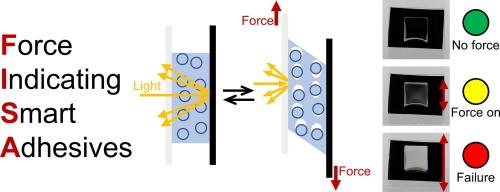Force-indicating smart adhesives enabled by mechanochromic elastomer
IF 13.3
1区 工程技术
Q1 ENGINEERING, CHEMICAL
引用次数: 0
Abstract
Adhesives are essential for binding materials and ensuring the integrity of structural systems. However, adhesive joints often experience force accumulation, leading to potential failure, which remains challenging to monitor in real-time. In this study, we introduce a simple, cost-effective, and versatile strategy for fabricating force-indicating smart adhesives (FISAs) using commercially available materials, including polyacrylate matrices and silicone microspheres as fillers. These adhesives exhibit a pronounced mechanochromic response, driven by reversible cavitation within the elastomer matrix, enabling both qualitative and quantitative visualization of stress distribution at adhesive joints. This capability allows for early detection of adhesive failure, offering a proactive warning mechanism. The adhesive properties, including force sensitivity, are highly tunable by adjusting the polyacrylate matrix composition, microsphere content, size, and interfacial strength, making these FISAs adaptable to a wide range of substrates. This work represents a significant advancement in smart adhesive technology, combining enhanced monitoring capabilities with broad applicability across diverse scenarios.

求助全文
约1分钟内获得全文
求助全文
来源期刊

Chemical Engineering Journal
工程技术-工程:化工
CiteScore
21.70
自引率
9.30%
发文量
6781
审稿时长
2.4 months
期刊介绍:
The Chemical Engineering Journal is an international research journal that invites contributions of original and novel fundamental research. It aims to provide an international platform for presenting original fundamental research, interpretative reviews, and discussions on new developments in chemical engineering. The journal welcomes papers that describe novel theory and its practical application, as well as those that demonstrate the transfer of techniques from other disciplines. It also welcomes reports on carefully conducted experimental work that is soundly interpreted. The main focus of the journal is on original and rigorous research results that have broad significance. The Catalysis section within the Chemical Engineering Journal focuses specifically on Experimental and Theoretical studies in the fields of heterogeneous catalysis, molecular catalysis, and biocatalysis. These studies have industrial impact on various sectors such as chemicals, energy, materials, foods, healthcare, and environmental protection.
 求助内容:
求助内容: 应助结果提醒方式:
应助结果提醒方式:


